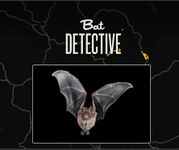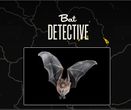The educational technology and digital learning wiki
Jump to navigation
Jump to search
|
|
| Line 14: |
Line 14: |
| |field_research_questions=Calls that bats use for socialising are not used for echolocation but communication, and these calls tend to be lower in frequency and have a more complex structure. Only under a third of all the echolocation calls of bats worldwide are known and even less is understood about social calls. Perhaps only 5% of all species social calls have been recorded. | | |field_research_questions=Calls that bats use for socialising are not used for echolocation but communication, and these calls tend to be lower in frequency and have a more complex structure. Only under a third of all the echolocation calls of bats worldwide are known and even less is understood about social calls. Perhaps only 5% of all species social calls have been recorded. |
| |field_team_leadermm=Kate Jones | | |field_team_leadermm=Kate Jones |
| | |field_main_institution=University College London |
| | |field_partner_institutions=University College London, Zoological Society of London, The Bat Conservation Trust, BatLife Europe, University of Auckland, the Citizen Science Alliance. |
| |field_team_link=http://www.batdetective.org/#!/about/team/science | | |field_team_link=http://www.batdetective.org/#!/about/team/science |
| |field_team_location=University College London | | |field_team_location=University College London |
Revision as of 22:41, 15 October 2013
Cs Portal > List of citizen science projects > Bat detective - (2013/09/25)
THIS PAGE DESCRIBE A CITIZEN SCIENCE PROJECT
Start date : 2012/10/04
- Beta start date : N/A
- End date : Still open.
⇳ Description
Bat Detective is an Zooniverse citizen science project which asks the public to turn detective to find bat calls in audio recordings across the world.
➠ Purpose
Mapping out bat ‘hotspots’ by using recordings and classifying the sounds they make for echolocation and social purposes.
? Research question
Calls that bats use for socialising are not used for echolocation but communication, and these calls tend to be lower in frequency and have a more complex structure. Only under a third of all the echolocation calls of bats worldwide are known and even less is understood about social calls. Perhaps only 5% of all species social calls have been recorded.
MAIN TEAM LOCATION
Loading map...
{"minzoom":false,"maxzoom":false,"mappingservice":"leaflet","width":"300px","height":"270px","centre":false,"title":"","label":"","icon":"","lines":[],"polygons":[],"circles":[],"rectangles":[],"copycoords":false,"static":false,"zoom":false,"defzoom":14,"layers":["OpenStreetMap"],"image layers":[],"overlays":[],"resizable":false,"fullscreen":false,"scrollwheelzoom":true,"cluster":false,"clustermaxzoom":20,"clusterzoomonclick":true,"clustermaxradius":80,"clusterspiderfy":true,"geojson":"","clicktarget":"","imageLayers":[],"locations":[{"text":"","title":"","link":"","lat":51.52420305,"lon":-0.13300072425929543,"icon":""}],"imageoverlays":null}
University College London
Project team page http://www.batdetective.org/#!/about/team/science
Leader: Kate Jones
Institution: University College London
Partner institutions: University College London, Zoological Society of London, The Bat Conservation Trust, BatLife Europe, University of Auckland, the Citizen Science Alliance.
Contact:
CONTRIBUTION TYPE: data interpretation
PARTICIPATION TYPOLOGY: crowdsourcing
GAMING GENRE NONE
GAMING ELEMENTS: NONE
◉ Tasks description
⤯ Interaction with objects
▣ Interface
- Data type to manipulate: sound
- interface enjoyment: cool/attractive
- Interface usability: easy to use
GUIDANCE
- Tutorial: ✓
- Peer to peer guidance: Somewhat
- Training sequence: Somewhat
FEEDBACK ON
- Individual performance: Somewhat
- Collective performance: Somewhat
- Research progress: Somewhat
❂ Feedback and guidance description
COMMUNITY TOOLS
- Communication:
- Social Network: N/A
- Member profiles:: N/A
- Member profile elements:
NEWS & EVENTS
- Main news site:
- Frequency of project news updates: N/A
- Type of events:
- Frequency of events :
⏣ Community description
- Community size (volounteers based) 671
- Role:
- Interaction form:
- Has official community manager(s): N/A
- Has team work N/A
- Other:
- Community led additions:
Other information
PROJECT
Url:http://www.batdetective.org/#!/home
Start date: 2012/10/04
End date: Still open
Infrastructure: Zooniverse
TEAM
Official team page:http://www.batdetective.org/#!/about/team/science
Leader: Kate Jones
Institution: University College London
Partner institutions: University College London, Zoological Society of London, The Bat Conservation Trust, BatLife Europe, University of Auckland, the Citizen Science Alliance.
Main location: University College London
PROJECT DEFINITION
Subject
Natural sciences > zoology (nature/conservation)
Description
Bat Detective is an Zooniverse citizen science project which asks the public to turn detective to find bat calls in audio recordings across the world.
Purpose.
Mapping out bat ‘hotspots’ by using recordings and classifying the sounds they make for echolocation and social purposes.
Research question.
Calls that bats use for socialising are not used for echolocation but communication, and these calls tend to be lower in frequency and have a more complex structure. Only under a third of all the echolocation calls of bats worldwide are known and even less is understood about social calls. Perhaps only 5% of all species social calls have been recorded.
ABOUT PARTICIPANT TASKS
.
.
| Grey typology |
Participation typology |
Contribution type: |
|
|
| Computing: |
NO |
Thinking: |
YES |
| Sensing: |
NO |
Gaming: |
NO |
|
|
|
| Crowdsourcing |
☑ |
Distributed intelligence |
☐ |
| Participatory science |
☐ |
Extreme citizen science |
☐ |
| Science outreach |
☐ |
| |
|
| Data collection |
☐ |
| Data analysis |
☐ |
| Data interpretation |
☑-------- |
|
| Gaming |
| Genre: |
Gaming elements: |
| Interface |
| Data type to manipulate: sound |
interface enjoyment: cool/attractive
Interface usability: easy to use |
Member profiles::N/A
Member profile elements: |
ABOUT GUIDANCE AND FEEDBACK
| Guidance |
Feedback on |
| Tutorial and documentation: |
YES |
| Training sequence: |
SOMEWHAT |
| Peer to peer guidance: |
SOMEWHAT |
|
| individual performance: |
Somewhat |
| collective performance: |
Somewhat |
| research progress: |
Somewhat |
|
.
| Tools |
News & Events |
|
Communication:
Social Network: N/A
|
Main news site:
Frequency of project news updates: N/A
Type of events:
Frequency of events :
|
| Community description |
|
Community size (volounteers based): 671
Role:
Interaction form:
Has official community manager(s): N/A
Has team work N/A
|
Other information about community:
Community led additions:
OTHER PROJECT INFORMATION
batdetective.jpg
Yes
[[has completion level::Low]
http://www.batdetective.org/#!/about/team/science
University College London
Yes
zoology
Natural sciences
nature/conservation
Mapping out bat ‘hotspots’ by using recordings and classifying the sounds they make for echolocation and social purposes.
Calls that bats use for socialising are not used for echolocation but communication, and these calls tend to be lower in frequency and have a more complex structure. Only under a third of all the echolocation calls of bats worldwide are known and even less is understood about social calls. Perhaps only 5% of all species social calls have been recorded.
Bat detective
data interpretation
crowdsourcing
sound, other:
Thinking: yes
Computing: no
Sensing: no
Gaming: no
cool/attractive
easy to use
yes
N/A
weak
N/A
N/A
N/A
N/A
N/A
N/A
671
N/A
N/A
Low
Bibliography



